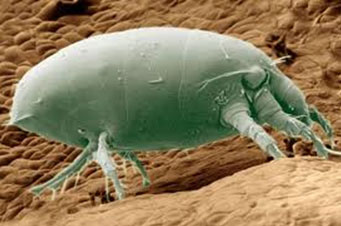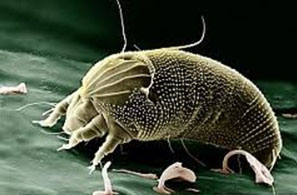 Mites are tiny microorganisms with features no different to those of any insect in complexity that possess an exceptionally detailed and complex structure, and are just 5 to -50 microns in size, visible only under the microscope. They live everywhere, in every corner of your home, in the bed you sleep in, the carpets on the floor, the air you breathe, wherever you spend your life. These entities, resembling tiny fat spiders, cover every square centimeter of our environment.
Mites are tiny microorganisms with features no different to those of any insect in complexity that possess an exceptionally detailed and complex structure, and are just 5 to -50 microns in size, visible only under the microscope. They live everywhere, in every corner of your home, in the bed you sleep in, the carpets on the floor, the air you breathe, wherever you spend your life. These entities, resembling tiny fat spiders, cover every square centimeter of our environment.
These arachnids feed on dead skin cells, which is why they are found wherever humans are present and are spread about by means of human activity, to where their feeding materials collect—generally beds and pillows, furniture and carpets.
No doubt the fact that human beings cannot see them under normal conditions, is an example of Allah's wise Creation. They are present in such great numbers that even in your bed, no matter how clean it may be, there will be an average of 10,000 of them. Yet they do not bite, or sting or spread diseases. They do no harm, so long as you are not allergic to the proteins they produce.
However, they do, harm some other species. In fact, they can wipe out a bee colony in which they live as parasites, by piercing a bee's exoskeleton and sucking out their bodily fluids. They are able to injure many insects, animals and plants in the same way; yet still others provide various benefits. For example, mites cause insect pests to die or fall ill, and the waste products they produce also increase soil fertility. Some parasitize many animals species, living in their ear canals, lungs and intestines.
During their life cycles, mites go through four stages; egg, larva, nymph and adult. This period between egg and adulthood lasts for about one month. The female egg-laying population increases by up to 25-30 times a week. Adult mites molt once and can live for up to two months, depending on environmental moisture levels and temperature.
Mites do not drink water, but absorb moisture from the air and their environment. Therefore, they prefer quite high levels of humidity, 70 to 80%, and temperatures around 270C When they find such a suitable environment, they can increase their numbers enormously. For example, there may be up to 6 million members in half a hectare of cultivated soil.
Mites are important cleansers In the environments in which mites live, there is household dust, fabric threads, particles of human and animal skin, shed hairs, bacteria, mould spores, food particles and other organic and synthetic substances. Mites feed on these, which is why they live in such close proximity to human beings. From that perspective, you can see that a great portion of these tiny arachnids help clean up the world, eliminating the scales, secretions, dusts, fungal spores, pollen and plant fibers that constitute their diet.
In the environments in which mites live, there is household dust, fabric threads, particles of human and animal skin, shed hairs, bacteria, mould spores, food particles and other organic and synthetic substances. Mites feed on these, which is why they live in such close proximity to human beings. From that perspective, you can see that a great portion of these tiny arachnids help clean up the world, eliminating the scales, secretions, dusts, fungal spores, pollen and plant fibers that constitute their diet.
The mites around us to perform this function are really very numerous. There are roughly 1,000 mites in one teaspoonful (1 gram) of house dust.107 These large numbers of mites are constantly active, engaging in highly effective cleaning. Were it not for mites, these micro-wastes would grow every day, until the Earth became uninhabitable.
Some mites benefit their surroundings still further, even though they are unaware of the fact. For example, mites of the species Pyemotes tritici generally multiply on stored cereals, dried beans and peas, in haylofts, and dried grass. They are highly useful to farmers because they paralyze and eliminate insects that feed on stored cereals and similar products.
Mites behave consciously
In difficult situations, mites display methods of protecting themselves. Clover mites, for instance, enter hibernation when the winter or summer climate does not suit them. When they realize that temperatures are above or below the interval they need to live, they slow down some of their metabolic functions and go to sleep. Now in suspended animation, these living things are unaffected by the conditions around them. When the temperature returns to an favorable level, they return to their former state and resume their lives.
Some mites use their insect and arthropod hosts to transport them to different locations. Mites of the species Dinogamasus for example live in a special sac on the stomachs of certain bees and can thus easily go to the sites they wish and where they can find food.108 In order for this process to take place, such a sac must first be specially created for mites in the bee's stomach. The mites in turn must be aware of this and think of using it as a means of transport. These arthropods lack the intellect to arrive at such a mutual agreement, and under normal circumstances, they should not sense the need for any such thing. This and similar examples in nature are clear proof that everything in the world has a single, superior Creator. Everything functions in the manner set out by Allah, with His permission and according to the destiny determined by Him. "There is no creature He does not hold by the forelock" (Surah Hud, 56).
This and similar examples in nature are clear proof that everything in the world has a single, superior Creator. Everything functions in the manner set out by Allah, with His permission and according to the destiny determined by Him. "There is no creature He does not hold by the forelock" (Surah Hud, 56).
In another verse, it is revealed:
That is Allah, your Lord. There is no god but Him, the Creator of everything. So worship Him. He is responsible for everything. (Surat al-An‘am, 102)


